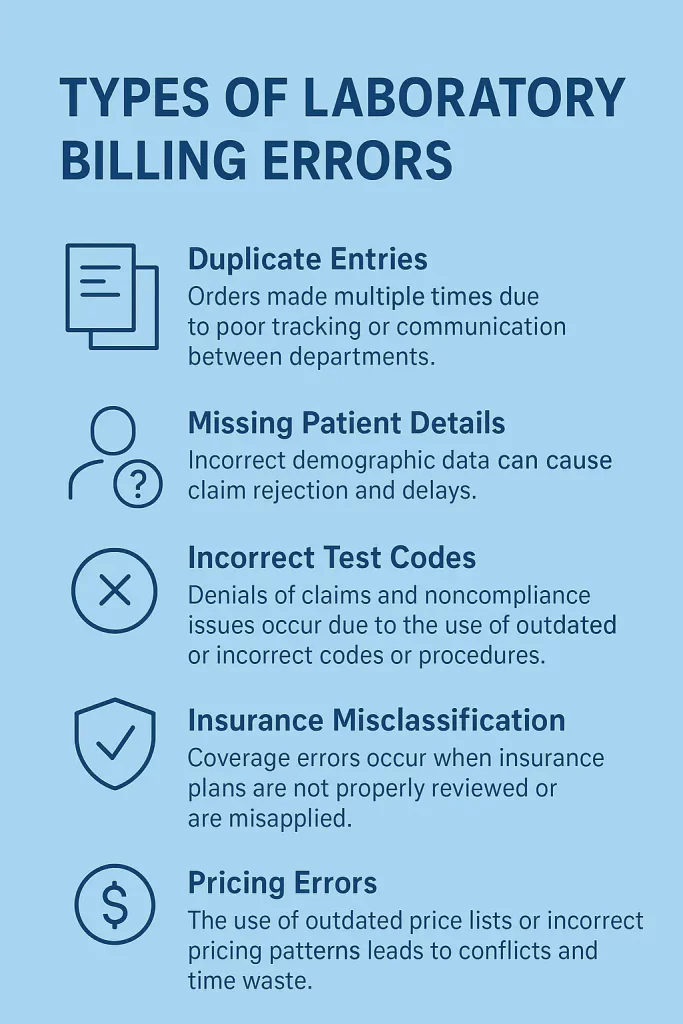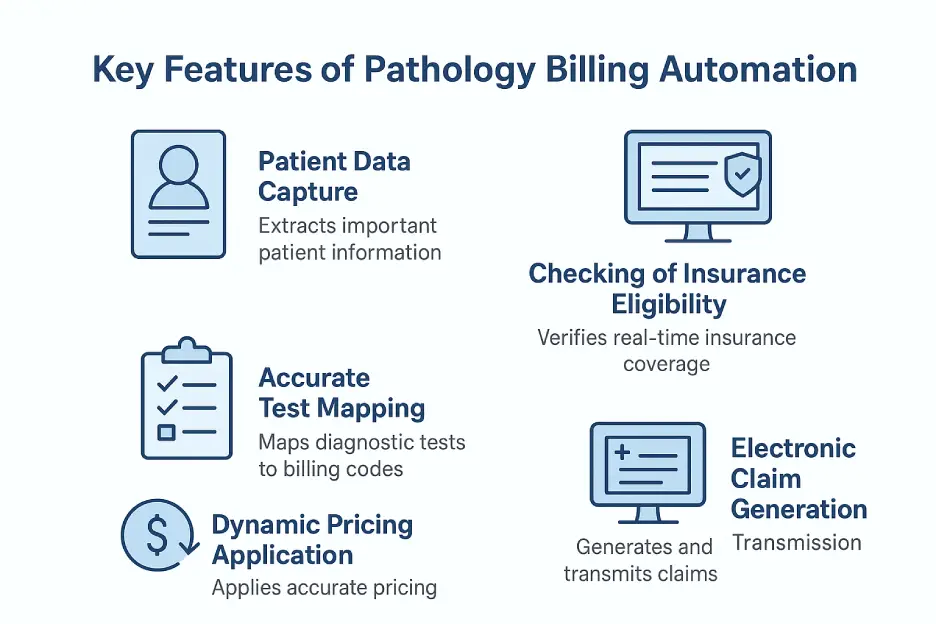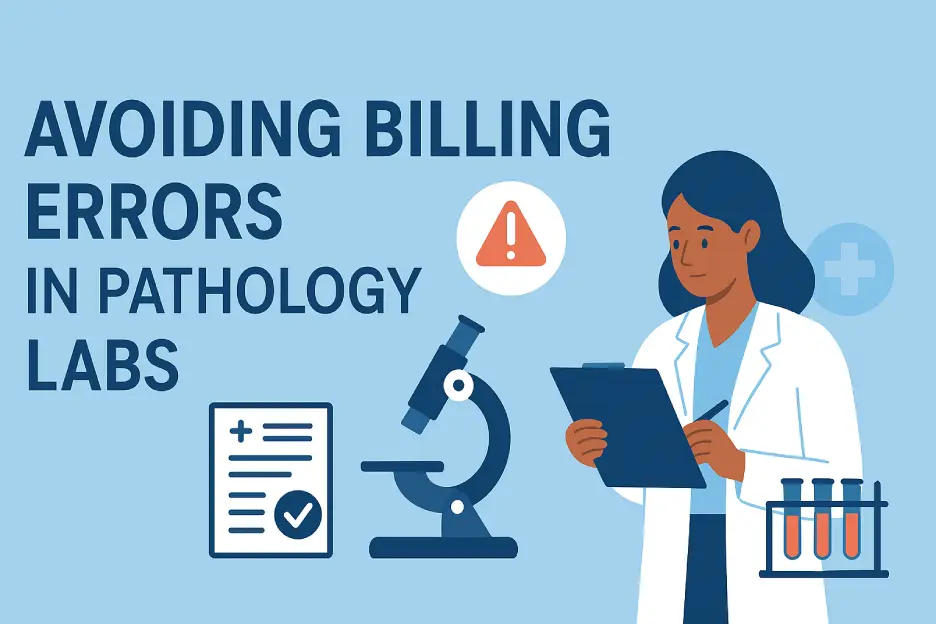Abstract
Any error in billing can create chaos in the very sensitive and time-sensitive atmosphere of a pathology lab that will lead to a significant loss of revenue and a loss of trust by patients and insurance providers. These are manual, miscommunication, or outdated system-based mistakes that create a major challenge to the lab efficiency and compliance. Luckily, the evolution of automation is transforming the financial processes of laboratories. Our innovative Laboratory Information System (LIS) at SpeedsPath combines Pathology Billing Automation and Revenue Cycle Management Automation, meeting the requirements of accuracy, speed, and compliance with regulations. Sample tracking, insurance verification, and many more, the automated solutions of SpeedsPath are transforming the way pathology labs handle bills, increase cash flow, and improve patient satisfaction. This blog explores how automation can support laboratories, reduce billing errors, enhance efficiency, and ensure long-term financial stability.
Introduction
A pathology laboratory is a vital institution in contemporary healthcare. They provide important diagnostic data that assist clinicians in making informed treatment choices. Nevertheless, as much as the technical piece of the technology has enhanced the speed and accuracy of diagnostics, the economics of the lab business still grapples with complexity. Pathology lab billing errors are quite frequent and may have a massive impact on the bottom line, operational continuity, and reputation of a lab.
With the digitization of healthcare, automation is not a possibility anymore but a necessity. Automation removes human error, ensures compliance, shortens reimbursement, and improves the interdepartmental transparency. At SpeedsPath, we believe in empowering labs with new tools that simplify their financial operations, including Laboratory Information System (LIS) billing, as well as Medical Billing Automation and Revenue Cycle Management Automation.
This blog discusses the prevalent reasons behind billing mistakes in pathology labs and how these challenges can be successfully addressed with the help of automation, with reference to the innovative solutions of SpeedsPath.
Knowing about Billing Mistakes in Pathology Laboratories.
Although pathology labs play a crucial role in patient care, they are often overwhelmed by ineffective and inaccurate billing procedures. The maze of tests, differences in insurance coverage, and large volumes of data render them especially susceptible to financial inaccuracy.
Types of Laboratory Billing Errors

- Duplicate Entries: Orders for tests were made multiple times due to poor tracking or communication between departments.
- Missing Patient Details: Incorrect demographic data can cause claim rejection and delays.
- Incorrect Test Codes: Denials of claims and noncompliance issues occur due to the use of outdated or incorrect codes or procedures.
- Insurance Misclassification: Coverage errors occur when insurance plans are not properly reviewed or are misapplied.
- Pricing Errors: The use of outdated price lists or incorrect pricing patterns leads to conflicts and time waste.
- Errors in Manual Computation: Errors in applying discounts, copayments, or bundled services contribute to administrative overhead.
These mistakes not only reduce the speed of cash flow but also raise questions about trust, influence patient satisfaction, and prompt regulatory attention.
Why Automation is the Game Changer
Manual operation has its own weak points and flaws. They are time-consuming, human memory-based, and not real-time validated. The automation eradicates such shortcomings with the offering of built-in controls, intelligent algorithms, and integration of data.
Automation ensures:
- On-the-fly verification of insurance and test records.
- Proper billing codes that minimize claim denials.
- Data is centered on one point, which reduces multiple entries and absenteeism.
- Quick turnaround of reimbursements helps maintain labs in good financial health.
SpeedsPath understands that automation is more than just technology — it is about a smarter workflow where employees can focus on more valuable activities rather than repetitive data entry.
Pathology Billing Automation – Precision at Every Step
Pathology Billing Automation is a cornerstone of SpeedsPath’s LIS platform. It addresses common pain points by automating routine tasks, which are often prone to error.
Key Features of Pathology Billing Automation

- Patient Data Capture: Automatically extracts patient details from registration forms, minimizing data entry errors.
- Checking of Insurance Eligibility: Verifies real-time checks on insurance plans to ensure coverage before billing.
- Accurate Test Mapping: Automatically maps diagnostic tests to the correct billing codes.
- Dynamic Pricing Application: Utilizes accurate pricing in accordance with service agreements and contract terms.
- Electronic Claim Generation and Transmission: Automates the construction of claims and transmits them to billers.
Benefits of Pathology Billing Automation
- Removes duplicated and faulty billing.
- Shortens the time required for invoice generation and approval.
- Lessens the rejection of claims and audits.
- Increases transparency and confidence with patients in pricing.
- Prepares detailed reports to be audited in accordance with regulations.
SpeedsPath LIS Labs have reported a noticeable reduction in claims rejected, as well as a streamlined workflow across departments, saving time and resources.
The Role of Laboratory Information System Billing
A Laboratory Information System (LIS) Billing module serves as the foundation for accurate billing. It ensures that diagnostic, administrative, and financial processes are interrelated and interlinked.
Why is LIS Billing Necessary?
- The electronic connection of test results to billing codes eliminates the guesswork.
- One-time verified insurer data entry helps to mitigate claim failures.
- Integrated Patient Profiles can automatically complete patient information, thus reducing manual entry of data.
- Billing claim transmissions are compliant with industry requirements like HIPAA, CLIA, and CAP.
Without LIS Billing, the labs experience problems of fragmented data systems, and this leads to inefficiencies and higher rates of errors. The LIS of SpeedsPath enables labs to avoid these traps, providing greater agility in their operations by integrating clinical workflows with financial systems.
Medical Billing Automation – Closing the Gap Between Care and Finance
Pathology labs are not isolated but are an integral component of a larger healthcare ecosystem. Medical Billing Automation not only automates the lab but also ensures that every stakeholder, including insurance companies and patients, benefits from efficient workflows.
How Medical Billing Automation Helps
- Code Mapping – Maps several tests and procedures to standard CPT and ICD-10 codes via diagnosis templates.
- Insurer Checks – Checks insurer data before sending claims.
- Validation – Allows billing teams a chance to validate and only release claims once corrected.
- Electronic Submission – It saves paperwork and speeds up approvals of claims, leading to quicker reimbursements.
When laboratories automate medical billing, they can handle claims faster, see fewer denials, and free up staff to work on more important projects. This leads to smoother operations and better care for patients.
Automation of the Revenue Cycle Management – From Registration to Reimbursement
The revenue cycle consists of the financial processes that include patient intake and payment. Revenue Cycle Management Automation ensures that every stage is optimized and connected. Labs are able to split the Technical and Professional components (TC/PC split) as well as share billing with their clients.
The Role of Automation in Revenue Cycle Management
- Pre-billing Validation – Ensures the claims are corrected before they are submitted.
- Claims Tracking Dashboards – Provides insight into the new, edited, archived, and sent claims.
- Failure Visibility – Displays the field claimed transmissions and provides the ability to resend after corrections.
- Data Analytics – Offers built-in billing reports and export of billing data for detailed offline analyses.
SpeedsPath enables pathology labs to enhance cash flow and operational efficiency across the departments by providing a 360-degree perspective on lab finances.
Automation Implementation -Best Practices in Pathology Laboratories
Automation not only requires billing module algorithms programming but also a plan to ensure its success.
- Select the Proper Technology Partner: Identify billing systems that can be integrated with your current LIS platforms. Solutions at SpeedsPath are designed to be scalable and compliant, offering flexibility while providing robust security measures. Integration with a number of billing systems is either available or may be custom-developed.
- Wash and Purify Data: An effective implementation begins with proper data. Perform audits, fix inconsistencies, and establish standards of input validation.
- Train Your Staff: Even the finest systems require human skills. Dashboard, data interpretation, and exception training.
- Observation and Evaluation: The periodic performance appraisals and audits are used to identify mistakes early on and improve the work processes.
- Create Teamwork: Make sure communication between the administration, medical personnel, and finance department is as frequent as possible in order to ensure the smooth running of the billing procedures.
Overcoming the Automation Problems
Although automation is associated with transformative advantages, the lab should be ready to encounter possible challenges.
- Resistance to Change: Working with manual workflow, teams may not be willing to work with new tools. The benefits should be expressed in a way that is easily understandable, and practical training is needed.
- Integration Issues: The old systems may not be compatible with the new software. With pilot testing, a phased implementation can be used to facilitate compatibility.
- Data Privacy and Security: The adherence to healthcare data protection legislation is not a bargain. Areas of access and secure encryption within access protocols protect sensitive information.
- Overreliance on Technology: Human decision-making should be supplemented, not abolished, by automation. Labs require procedures in dealing with complicated cases and exceptions.
Automation in the Real World
Research indicates that automation in labs is associated with great improvements:
- A 40 percent decrease in billing errors.
- Claim approvals and reimbursements are 30 percent faster.
- Major reduction in insurance rejections.
- Improved patient and client satisfaction because of effective billing.
- Reduced the cost of operations and reduced manual intervention.
At SpeedsPath, we have witnessed firsthand the power of automation to enable labs to scale their billing without sacrificing accuracy or compliance.
Summary – Desirable Automation for the Growth of Sustainability
Pathology lab billing mistakes cannot be taken lightly, and automation provides an effective solution to this problem. Since there is Pathology Billing Automation, Laboratory Information System Billing, Medical Billing Automation, and Revenue Cycle Management Automation, the appropriate tools can make labs remain efficient, compliant, and financially stable.
The future of pathology is adopting smart and automated solutions, which are not only able to eliminate mistakes but also to inspire confidence, transparency, and operational excellence. Problems of Integration: The new software might not be compatible with the old systems. The LIS at SpeedsPath is designed to facilitate such transformation and enable the labs to manage complexity with confidence.
When you are willing to take your billing efficiency and accuracy to the next level, get to know how SpeedsPath can transform the way your lab operates. Request a demo today.
and make the initial leap on the way to smarter, error-free pathology billing.

